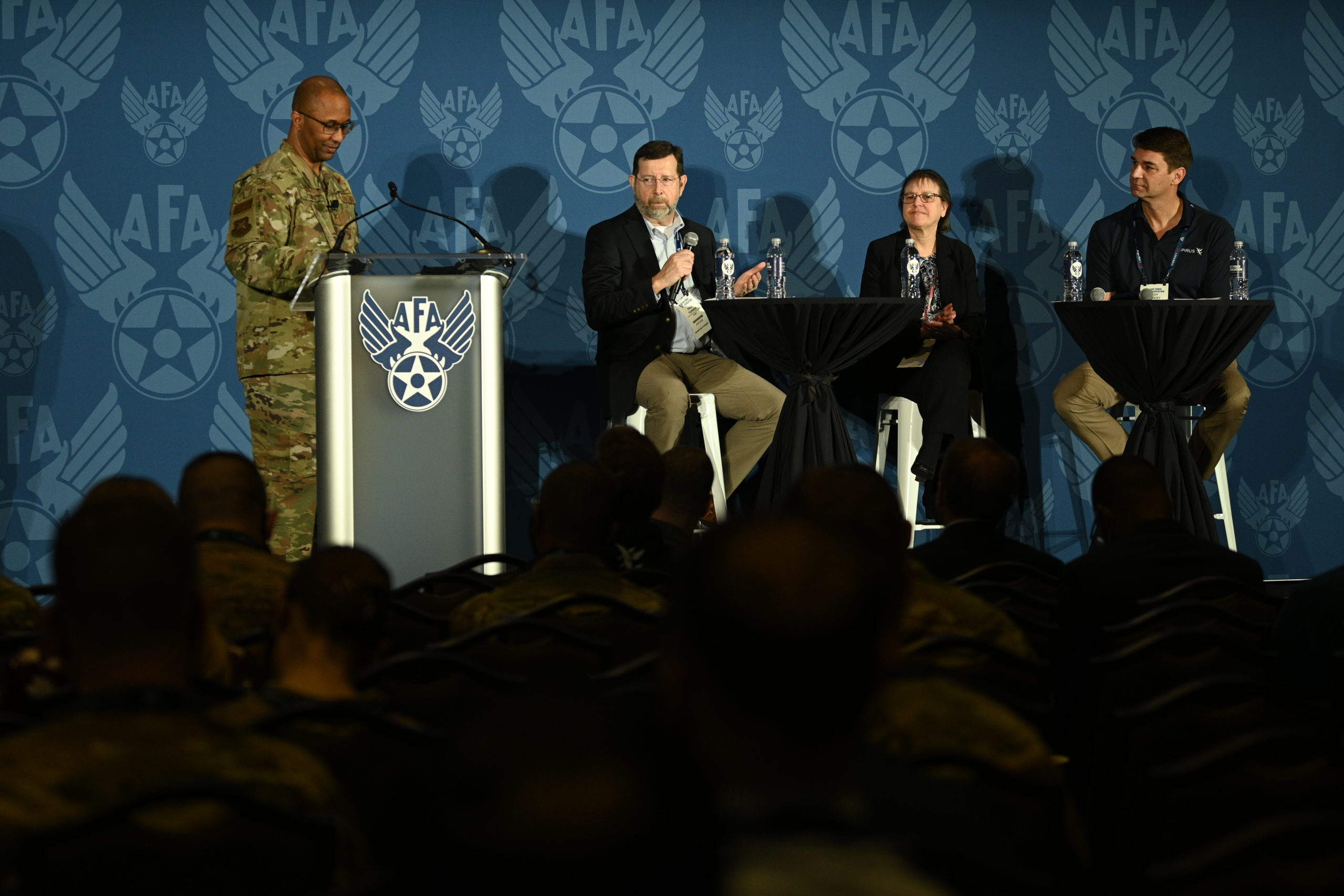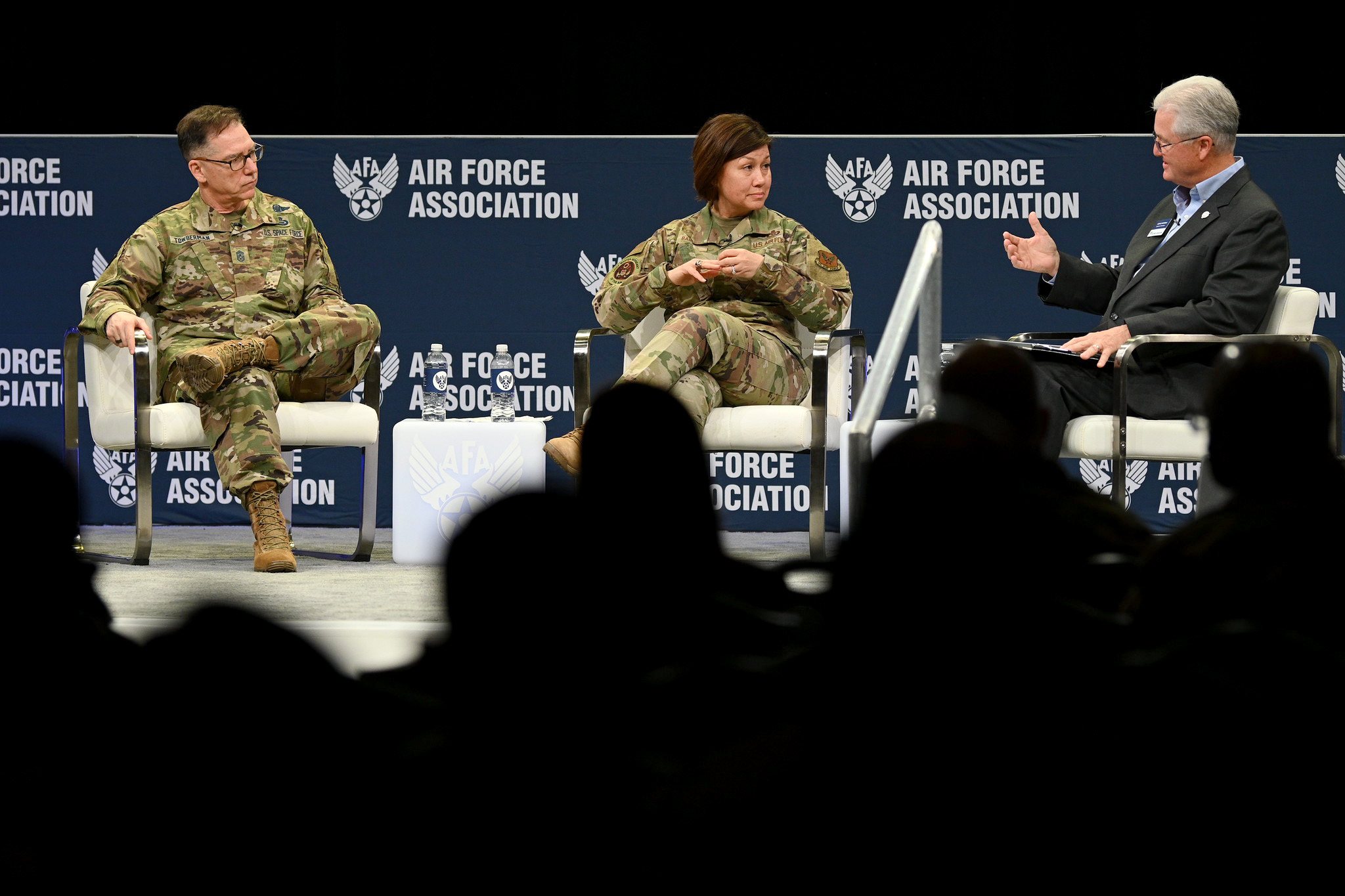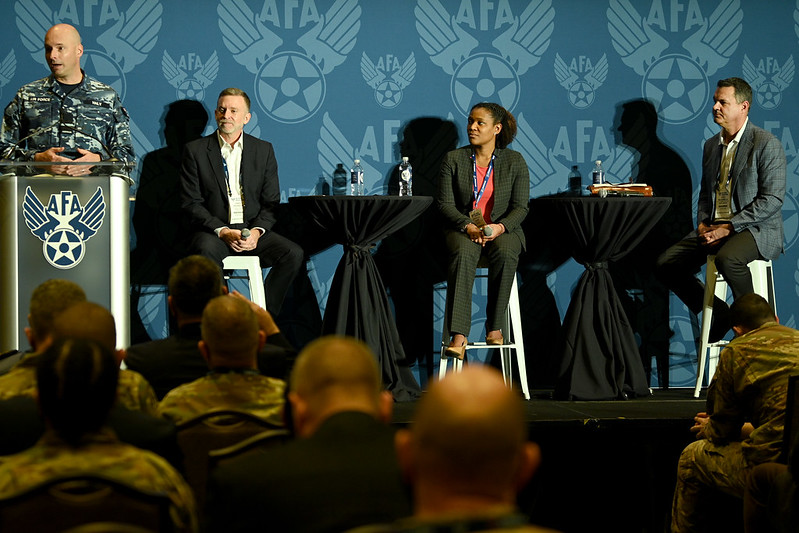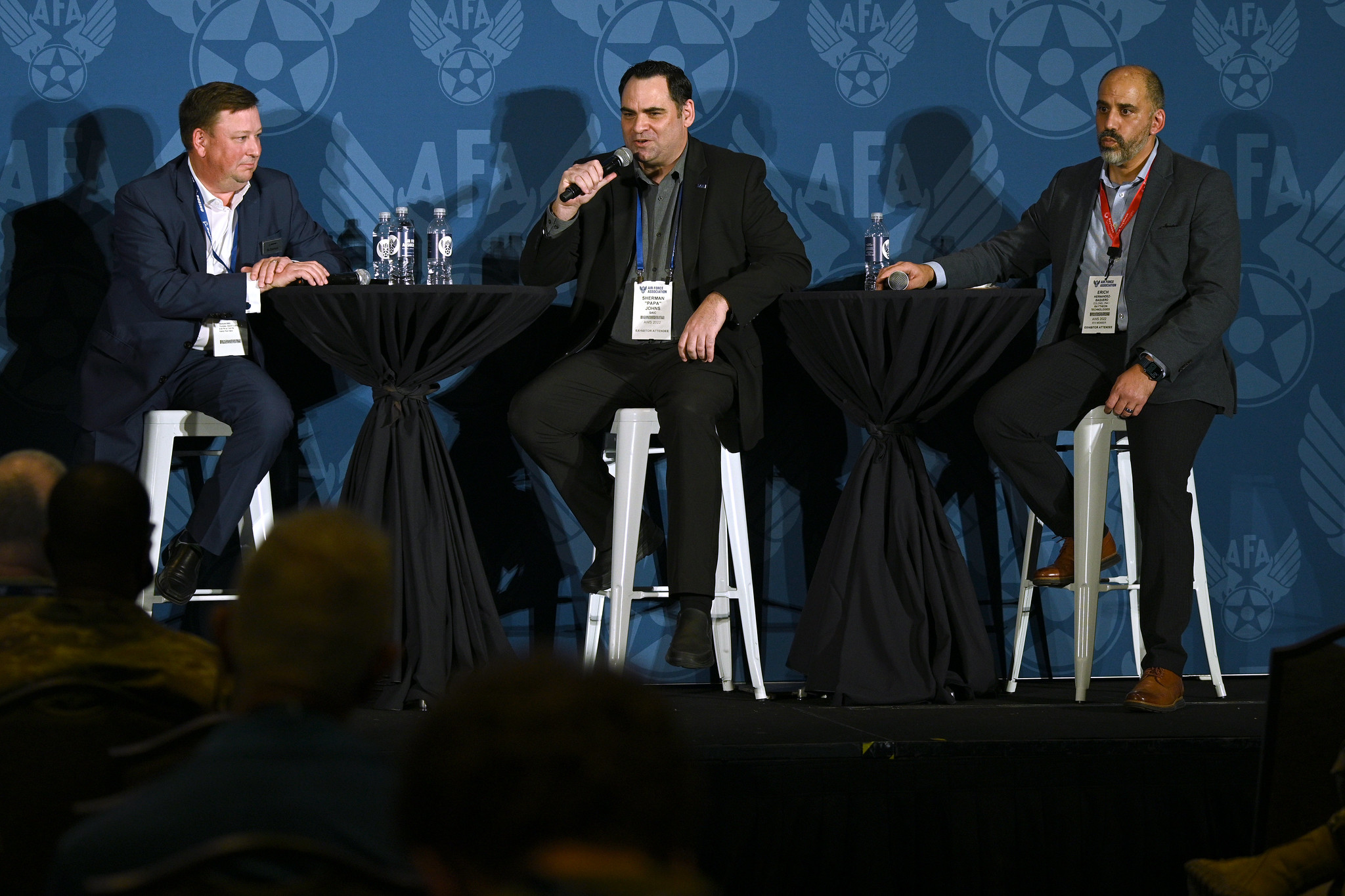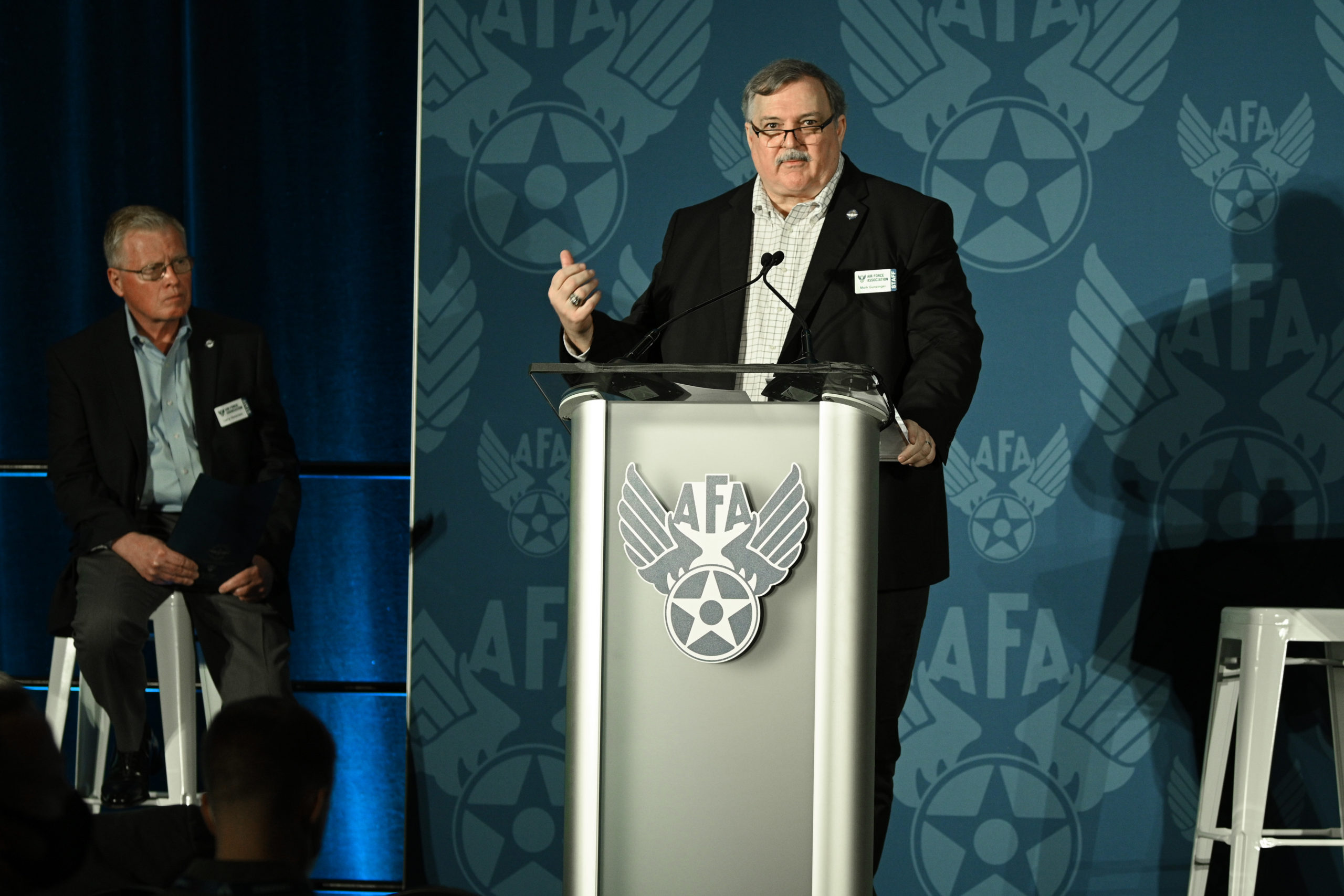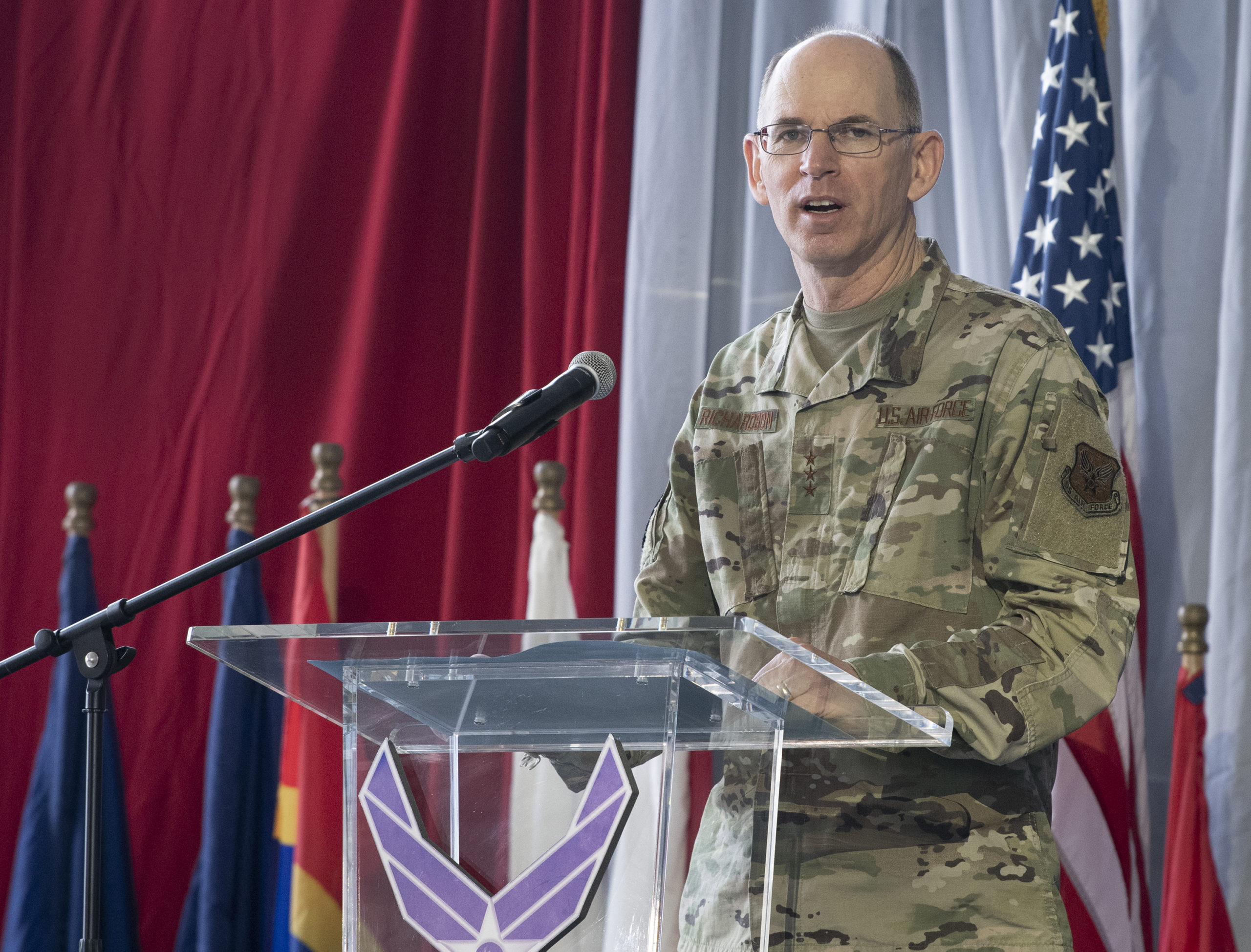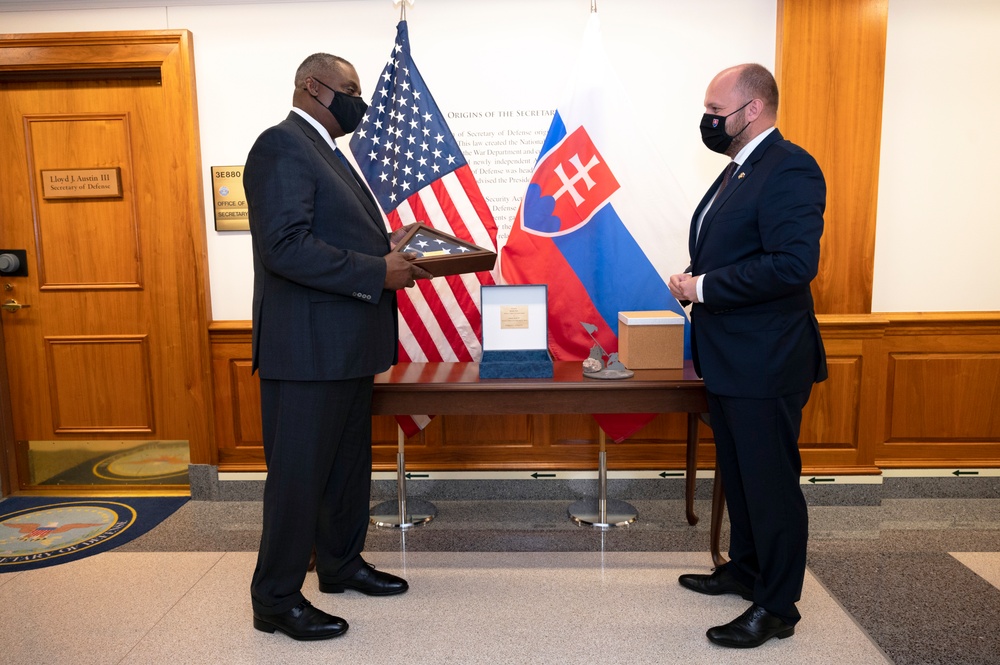Col. William E. Young Jr., commander of the 350th Spectrum Warfare Wing, moderates a discussion with Paul Turner, the principal product development engineer with AT&T Public Sector; Lisa Aucoin, the vice president of F-35 solutions for BAE Systems; and Andy Lowery, chief product officer for Epirus on electromagnetic spectrum, or EMS, warfare during the AFA Warfare Symposium on March 4, 2022. Watch the video or read the transcript below. This transcript is made possible through the sponsorship of JobsOhio.
Col. William E. Young Jr., commander of the 350th Spectrum Warfare Wing: Good morning. I hope that everyone enjoyed that coffee break. And welcome to our session on electromagnetic spectrum warfare. I’m Col. William “Dollar” Young, the commander of the 350th Spectrum Warfare Wing. And I will be your moderator for this morning’s panel. Things are moving fast in the EMS space. In the last year, the Air Force has stood up the 350th Electromagnetic Spectrum Warfare Wing to truly get after these challenges from an organizational perspective, but it’s a whole-of-nation challenge, which is why I’m honored to be joined by our distinguished panelists on the stage this morning.
Members of Congress have called for a military head of EMS warfare and Defense Secretary Lloyd Austin recently approved an EMS superiority strategy for the Defense Department. It’s becoming clear that the U.S. military faces an all too familiar choice: accelerate change or lose. On our panel today, we have Paul Turner, principal product development engineer for AT&T Mobility and Access Architecture; Lisa Aucoin, Vice President of F-35 solutions, BAE Systems; Andy Lowery, Chief Product Officer at Epirus. I’ll have each of you introduce yourself and give us a few opening remarks.
Andy Lowery, chief product officer for Epirus: Thank you, Colonel, and thank you to the AFA for hosting us here in this wonderful event. And great time, it’s my first event, but I’m having a really fantastic time at it. So first, just a little bit about me, I’ve been in spectrum warfare and electromagnetics for the majority of my career at MACOM for a long while, then followed by Raytheon, as the chief engineer. There, I met a man named Dr. Bo Marr, who had an idea about a better way of building a defense company that could pace technology with or could sell technology at the pace that the DOD needed in order to kind of keep up with the rapid growth of what we’re seeing. So about a year ago, I joined Bo on this quest at Epirus. And I look forward to the panel today. Thank you, Colonel.
Lisa Aucoin, vice president of F-35 solutions for BAE Systems: Thank you, Colonel. And thank you to all the audience and to the AFA for hosting this as well. A little bit about me, I’m the vice president of F-35 Solutions. I have about 35 years of experience, ranging in engineering, operations and micro electronics. I can talk really loud …
Event coordinator: Because of the stream, we have to make sure that it’s amplified out over the stream. My apologies.
Aucoin: Yeah, OK. Yeah, we’ll continue with this one. OK. All right. And so, engineering operations, and program management, actually really started my career doing device design, which is kind of foundational to all of the high speed electronics that are really important in the electromagnetic warfare spectrum. So we’ll talk a little bit about that later. Recently, I was the vice president of engineering at our electronics system sector, leading a group of about 5,000 engineers and I’m really excited today to tell you about what we’re doing to advance electronic warfare at BAE Systems.
Paul Turner, the principal product development engineer with AT&T Public Sector: Thank you. I’m Paul Turner, I go by Kip. I’ve been with AT&T, Southwestern Bell and AT&T, a little over 48 years in roles ranging from field maintenance to supervisory roles now with the wireless access and architecture team of AT&T Labs. Recently within the past year have been assigned to help our DOD public sector teams, make sure that we’re using the latest technology, RF technology.
Young: All right, so as you can see, we are really in for a treat with such a distinguished panel this morning. So let’s go ahead and kick it off. Paul, let’s start with you. How was the DOD shift to electromagnetic spectrum operations, or EMSO, changing our approach to electromagnetic warfare, and how should telecommunications providers plan and prepare?
Turner: Great question. As we were discussing these questions, it should be no surprise that most telecommunications providers really don’t think much about electronic warfare. We have started. But we do things to ourselves. For instance, an AT&T site may have up to eight different spectrum bands, ranging from 700 megahertz, all the way up to 39 gigahertz, operating at fairly high powers. We create passive intermodulation when things in front of the antenna passively generate frequencies that come back to us and actually jam our signals. So we developed mitigation solutions for those working with our suppliers. And we’re anxious to test those solutions against real EW.
Young: That’s actually very interesting, especially given the challenge of putting together various capabilities that have to operate and share the electromagnetic spectrum. So if I could pull on that thread just a little bit, how could the DOD’s approach to electromagnetic protection, or EP, change to ensure that this important aspect of EW is appropriately resourced and coordinated across programs?
Turner: Well, I feel like the DOD could help to ensure that research continues, encourages the telecom industry, participation from both providers and suppliers to harden their systems against potential EW. Consider things like multifunction research, such as equipment that can perform both communication and detection development.
Young: OK, and then if I could just one more, because one of the constant challenges we face is ensuring that the various disciplines that are required to execute this set of highly complex operations doesn’t fratricide, kill each other and getting each other’s way. So if I can just get your thoughts on how should the DOD change its approach to the relationship between EW, cybersecurity, and network requirements to achieve better results.
Turner: It appears the DOD is already changing its approach via the U.S. Cyber Command. However, as previously mentioned, I believe they should encourage ongoing research, development and foster coordination with wireless service providers, suppliers in the telecom industry to mitigate and prevent EW. I also think, and this is not something that’s talked about a lot, should encourage alternative hardened solutions to our synchronization systems. We use, all wireless providers use GPS, and it’s vulnerable at some, some stages. With 5G systems, especially depend on synchronization when you’re talking TDD, time division domain modulation to avoid interference. If we lost that synchronization, you could lose entire networks.
Young: OK. So let’s shift gears a little bit. Lisa, I’d like build upon your perspective and your experience building fighter EW over a distinguished career. And my first question is, what’s the role of a modern EW system on a fighter aircraft?
Aucoin: Thank you Col. Young for asking that question. So, you know, I look at this as the modern electronic warfare has three really principal duties. First and foremost is to provide 360-degree situational awareness in real time to the battlespace for the pilot. In addition to that, we also have to provision for threat warning and countermeasures. By passively geo-identifying, or actually by passively, by detecting, geo-locating, and identifying threat emitters in a highly dense signal environment, which gets even better with all these 5G networks, right? We allow the pilot to be able to figure out whether or not he or she should engage or evade from the target, right.
I will further say that today’s modern EW systems are actually an integral part of the overall weapon system on the fighter aircraft. And so we allow the pilot to focus on that mission to either identify and evade, identify threats without interference to the radar, or the radar warning receiver. And that’s a really important capability in these complex systems. And then survivability, we really need to continue to employ RF and IR countermeasures to ensure the survivability of the pilot and his or her team.
Young: Let’s draw a little bit more on the contested nature of the conflict in the electromagnetic spectrum. Can you can you tell us how are the potential adversaries’ efforts to challenge EMS superiority impacting EW modernization?
Aucoin: Also, again, a great question, I think it’s of no surprise to the audience here that our adversaries have gained on us. Right, they haven’t been standing still when it comes to exploiting the electromagnetic spectrum as well. So relying on stealth, as we have in the past, is no longer a sole option. Right? And we complicate this picture, because the density of signals out there is getting greater and greater. And the commercial space is contributing to that. This makes the job of electronic warfare a lot more difficult. And so we really have to apply new techniques to help us identify those threats.
And, you know, I think one of the key pieces here is employing the entire spectrum, not only RF, but IR, to kind of branch that range of frequencies, to enable us to detect more threats in real time. Innovations in hardware and software that provide greater instantaneous bandwidth, improved emitter identification, greater sensitivity to the radar and high-speed scanning are key technologies that are imperative for us to keep ahead of the threat. These new techniques will evolve as the threat evolves, and we have to go faster than our adversaries.
Young: All right. And just one more if I might, the F-35, I believe is an exemplar of a complex system. What are a few emerging key system attributes that are required to stay ahead of the threat?
Aucoin: So thank you for that question. So I have a few of those that I think are really important, right? At BAE, we actually have a saying in our EW world, which is, speed is life. When it’s time to survive, you have to be faster than our adversary. So you need to adapt quickly. And how are we doing that at BAE Systems? One of that is to develop a common hardware platform that supports third-party software so that whoever has the best idea for countering a threat emitter in, in battlespace can do that. It reduces our cycle time so that we don’t have to re-invent and build new boxes every single time we need to upgrade our electronic warfare capability.
It also improves our sustainability. So the maintainers out there are able to switch LRUs very quickly if a downed aircraft is in a state of battle with another LRU out of another aircraft, or even potentially, in the future, another fighter jet. The other thing we need to do is to be very agile. So there are ways that we can non-kinetically confuse the enemy using advanced cyber techniques and spectrum denial that confuse our enemies that we can evade safely. I think one of the key things is that the future of electronic warfare is really about a low latency optimized to process a lot of data at a very high volume with … imperceptible delay. So, on target.
Young: All right, thank you very much. Andy, let’s shift gears and move on to you. You’ve been in the EW space for two decades now. Can you tell us a little bit, tell us more about Epirus, your journey to the company and what do you see as the most pressing capability gaps in DOD’s approach to EMS capabilities?
Lowery: OK, thank you, Colonel. Yeah, first of all, I kind of gave my background in the opening. So I’m still that same guy. So you can rewind if you didn’t see that. Anyways, I think the more pressing question we spoke about when we met not too long ago, around gaps in the DOD. And Lisa, you were just kind of referring to, you said a very special word. You said agile. And I think everyone in electromagnetic warfare spectrum warfare knows that it’s a cat and mouse game. So one of my jobs along the way was the next-generation jammer chief engineer. I’m the one that bid that to NAVAIR a number of years ago. But what I learned while doing chief engineering of that system is that the adversary is always getting better. And by trying to procure new systems all the time, new hardware all the time, and single functionality, isn’t working.
So what we’re looking for at Epirus and what we’re working towards at Epirus is multi-function, software-defined systems. Right? So what’s key about that is that I can take a system like our flagship product, Leonidas, which is a directed energy weapons system, that’s designed primarily to go after, counter drones, all groups, all types, commercial off the shelf, and even militarized, hardened ones. It’s designed to go against those types of drones. But we made the system completely software-defined, so that as the threats evolve, we can evolve. Let’s say a new threat emerges that’s not a drone, it’s another piece of electronics; our system can be updated with apps or missionware, as we like to call it, I’m learning Colonel, you teach me, and we can do that on the fly. So that means a warfighter has a threat they haven’t seen before we identify it, we study it, we send out to the field real time over the air updates. And now that threat can be taken care of.
I think you know, in general, that type of approach to upgrading systems and such will help with keeping pace with—there’ll always be bureaucracy in DOD. And I think by going to software defined systems, primarily software0defined systems will help keep pace with the pace of technology with DOD.
Young: All right, so I want to pick it that just a little bit because what you’re describing sounds amazing. But many people might say, “Well, Andy, that’s just science fiction. What makes you think that you can in very near term, be able to deliver that capability for the warfighter?’
Lowery: Whoa, that’s a great question, too. So yeah, my last company actually, I founded, I called it Realware, and I use the word Realware because I had gotten sick and tired as the chief engineer of looking at vaporware. Have you all seen some of that? I haven’t, I’ve never seen vaporware. I’ve seen some PowerPoint charts that describe it. But I haven’t seen the systems. So at Realware I always decided to advertise behind where I’ve advanced to in my systems, in my readiness. And that’s the same culture we have at Epirus. We don’t talk about things that are not ready to feel. And a lot of these things sound like science fiction, but they are science fact. And in the consumer world, they’re moving at a pace to create that science fiction into science fact every day. And that’s, you know, going back to the word agile, I mean, that’s the definition of Silicon Valley, is agile.
So at Epirus, what we’ve done is blended Silicon Valley Tech, Silicon Valley folks that come from that field, the consumer commercial field, with solid aerospace and defense executives with the aerospace approach. And by blending those two models, we think that we can continue to define, build, I’m sorry, software-defined systems that are answering the needs of the warfighter today, and then being able to evolve into the warfighters needs tomorrow.
Young: All right, well, I think everyone in the room would recognize and acknowledge the fact that within DOD, we have a bit of a challenge in terms of procurement and acquisition. So Andy I’m going to come back to you for one more, and I’d like to get your thoughts on how can DOD procurement processes and timelines better match the rapid pace of innovation we are seeing from companies like Epirus to ensure our warfighters are equipped with technologies to counter emerging threats.
Lowery: Well, that question’s like almost as hard as the meaning of life, I think, so. So, right. So on our side efforts, that’s what our mission is, is to be there, be that partner with DOD in rapid advancement and rapid fielding of new capabilities. However, just truth be told, it’s not totally easy to do. And it’s not totally easy. But working in conjunction with different groups like DIU, defense, defense innovation unit, or RCCTO, there are methods being done nowadays to help with the advancement of, the maturation of the product, and the competition of the product. So I think doubling down and building awareness on what’s available to the various military commanders and what types of pots of money that they may have access to that they don’t know that they have access to, I think that might be a good way to wedge sort of the ability for DOD to keep up with the pace of technology. And that’s really the ultimate threat is, we have the engineers to keep pace in America. Do we have the right systems and processes to allow us to keep pace? I guess that’s what we’re hoping for.
Young: So you’re saying there’s a chance?
Lowery: There’s a chance.
Young: All right. Well, ladies and gentlemen, at this time, what we’re going to do is we’re going to open this up to your questions. And so we have a mic prepared at the center of the room. And what I would ask if you’ll please come to the mic, and identify yourself and state your question, please, and we’re looking for the really, really hard questions for this panel.
Yes, please, if you’ll come to the mic. And for those of you that are thinking of your questions, if you’d like to make your way and then we’ll just form a line, and then we’ll just go question after question.
Question: I guess is directed at Mr. Lowery or the whole panel. You talked about doing electromagnetic pulses as a defense weapon? What about offensive laser technology? Have you looked into that? Or anybody working on that at this time?
Lowery: Oh, thank you. Great question. So just to repeat, the question is, what about laser technology? OK, laser technology is spectrum, it’s just way high up in the frequencies. And as you get high in frequencies, you have other side effects. Everything’s a pro and a con, a laser can provide very destructive energy with missiles, to missiles, to drones, to that sort of thing. But it continues to go on and on and on beyond the actual target that it’s implemented on. So the actual, you know, sort of the science behind that is a little tricky, and you need to be extremely safe with your keepout and all that.
The other thing about lasers is they’re not very efficient. So how I won, how we won at Raytheon, next-generation jammer, was focusing on end-to-end system efficiency. Because if you make an inefficient system, you’ll need a lot of cooling and a lot of power, which equates to a lot of weight in order to power the system and make this system feasible. What we’ve done is we’ve exercised, not a new concept, but maybe a new concept in this particular area, where we’ve created a microwave-phased array out of gallium nitride. And Lisa used to run the Andover fab and knows how great gallium nitride is when it comes to solid state. And versus some approach with high powered microwave will do a single channel, maybe a TWT or klystron or something like that. And it will all flow through there, very high power, but due to the single channel, there’s limitations, and there’s drawbacks and side effects. Whereas in a phased array, you have a distributed amplifier front, so each amplifier is less power. But as you phase it up in front of the array, it allows you to get greater and greater powers, but also have the flexibility of electronic steering, the flexibility of complete wave control polarization, wavelength, frequency, all sorts of things. So when we talk cat and mouse, high-powered microwave system, that single channel is sort of a one-trick pony. A laser is a one-trick pony, a software defined phased array system that has an intelligent front end with embedded ML and AI, which is what Epirus’s real claim to fame is, is our smart power, that does the work of that phased array to get those powers and energies to where we need it. That’s sort of where I think the warfighter needs. That’s the type of system the warfighter needs. So thank you.
Aucoin: Yeah, I’ll just I want to add to that. Just a quick, quick thing. What you said about high power microwaves, advances in that as a use in the electromagnetic spectrum is really important. But I will say that at BAE Systems, we’ve been doing laser warning on rotary aircraft for a long time. And so the challenges around swap and efficiency are real, but they’re known. And so it’s really an engineering problem to understand how you put the right and appropriate laser, and what the function you want that laser to do, whether it’s, you know, directed energy, or whether it’s laser warning, to protect the pilot in the aircraft.
Question: I’d actually kind of like to piggyback on your answer to the last question. And that that’s when you start talking about these advanced systems that both have really intricate micro electronic hardware, you mentioned, again, I’ll do all our front end, as well as the software defined on top of it. How do you in a company, or in a customer, manage both the software community and the hardware community, which tend to work in different buildings and different career paths and define themselves as one or the other? And how do you integrate that? And can a company do one and not the other? Are there advantages to having both?
Lowery: That’s a great question. And you know, depending on the company size and scale, and how they’re organized, I think there are different answers. So you know, I would turn over to AT&T and BAE for the larger company answer. Epirus is a startup, it has about 200 employees, and we view ourselves as Skunkworks. I mean, the modern 21st century Skunkworks. And so, we know, we don’t cohabitate like they did up and out there in the desert, but we do kind of live drink, breathe together, we’re kind of a community. And I think that integration, in what I’d call an appliance model, is key. At some point, the software gets down to an embedded level, and it’s talking to chips and hardware. And so at some point, there’s an interface between software and hardware. Our systems largely rely on embedded software in order to do the smart power, the arbitrary waveform generation and all of that. So it’s a coupling that actually makes a lot of sense. When you get into the more abstracted layers, the higher over the operating system layers, we have a separate group that we, you know, basically have good interface meetings with, with the embedded system group. And that’s how we arrange it. At Raytheon, it wasn’t too different, but just a much larger scale.
Turner: Well, within our group in AT&T, one way that we approach it, we have both software roadmap engineers, and we have hardware roadmap engineers. They work with the same supplier, for example, a Nokia or an Ericsson. And they work in concert. So by organizing to put those functions in the same groups, and we do the same thing on our core side as well. It’s generated some efficiencies over the years.
Aucoin: So I’ll add to that from BAE’s standpoint, right? We are very, we’re a very large company. And so a lot of our engineering is matrix. But the important part of the matrix piece of this is that when we identify a program or a capability, right, we pull all of those different functions together. So in the case of F-35, for instance, right, we actually organized by something called Drop, right? So we have a given capability. So all of the engineers, systems software, I like to put my firmware engineers in the category by themselves because they have very multifunction, the multi-discipline, and our hardware engineers together. So they understand what the end item goal is for that capability. So we that’s how we organize.
Question: OK, this question is aimed at Andy from Epirus. So software-defined radio, my understanding is definitely gives you the ability to change systems much quicker. But I guess a quick thing that I’m wondering typically when I think of hardware versus software, I think of software as, in terms of real time, as significantly slower than hardware based solutions. I was wondering if you could talk to, is that myth now? Or have things changed with technology?
Lowery: Yeah, that it’s, I guess we could get a little complex. But every sort of piece along the chain of the engineering system is being advanced. And one of the big advancements that are enabling a lot of this digitally defined system is the ability to do rapid digital to analog conversion. So rapid D to A so they can do direct synthesis of anything, I can just program into the computer, and I can synthesize it and create an RF waveform. The issue has been a lot, is in the antenna, because after it gets generated and turned to RF and converted, the antenna is usually single purpose, it just does pulse or it’s compressed or it’s that—at Epirus, what we’ve done is we’ve evolved that thinking and we’ve embedded what we call RF smart power within the antenna, and modulate the amplifier in a way using a typical fixed voltages. We modulate those voltages in order to create a definable antenna. So you can think about our phased array as being able to dictate it. OK now, it’s a radar antenna. Dot dot dot … now it’s a high powered microwave antenna, just by programming at a system level. So again, getting back to that previous question about embedded or firmware engineers at Epirus, they’re key to the embedded machine learning that we do and the antenna that can adapt with the missions, whether it’s comms, whether it’s software defined radios, whether it’s software defined radars, which are now becoming more prevalent, we can attend to all of those things. Thank you for the question.
Question: Hey, Dollar. A question from a Wild Weasel. Let me continue to pick on Andy here. Andy, we’d heard about HPM and high powered microwaves for the last 20 plus years. And they were going to be a panacea that solved a lot of things. And it never panned out. What’s different now?
Lowery: Thank you, sir. Yeah, that’s a great question, too. And I think—I mean, Lisa is almost like, has a similar career path as me, she could probably even talk to this. The big thing is, that solid state, wide bandgap materials like gallium nitride and other more advanced systems have now become rugged enough, with enough power handling capability, enough thermal dissipation capability, to become as powerful as the traditional methods, which are TWT-based, single channel. If we can meet the same power requirements as the older systems that can kick in the back door and produce these effects, a phased array system allows you infinitely more opportunity to put more energy in the system, to have harmonic type effects in the system. And all of those software defined things that allow me to do that on a older sort of legacy system, they didn’t think about those things, you know, back in the 1960s, when they were doing TWTs. They said, what’s that? They don’t even know what software defined is. So those are the same technologies that some of the other systems are being fielded with. And they come with a lot of human factor, bad byproducts. And so I think that was probably another reason why HPM didn’t take off, is that there’s a lot of different human factor issues associated with those types of amplifiers. So anyways, Lisa, maybe you have something to say as well, from your experience?
Aucoin: Well, not too much. But I will say that the big challenge still remains, which is how do you get all that heat out? And until we can solve that heat problem, you’re, you know, we will continue to be, in my opinion, probably the TRL 4 level. And that’s really, we need some real key innovations in microelectronics that allow us to have some unique materials that dissipate heat very rapidly for that.
Lowery: And with more power, driving efficiencies up to the 90s. So that, you know, if you have a high conversion of DC energy to RF energy, then obviously you don’t create as much heat and so Leonidas is just air cooled. It’s it’s conduction, cooled, phased array, because of the incredibly high efficiencies RF smart power is able to produce.
Question: Good morning. I’m Deb Driver. I’m with Huntington Ingalls Industries. And as Dollar knows, we worked with him and the others on the EMS ECCT. We have a couple people here this for this conference and we have heard EMS and EW only a couple of times. We were excited to see this panel on here. But that tells us that there’s probably some additional advocacy to be done for the issues here, there are a lot of very difficult technical challenges. And if we do not own the spectrum, we won’t be able to fly, fight and win. If we don’t accelerate the change here, we will lose. I’d like to hear from the panelists about what the government can do, what the Air Force can do to help you proceed in these regards. And then I’d very much like to hear from Dollar what he would like to see happen as he’s departing. Thank you.
Turner: Well, we have a little bit different spectrum position at AT&T. And any wireless provider, we have to use licensed spectrum, we typically, we do use unlicensed spectrum, but we don’t advocate that as much. We do the best we can to protect our spectrum. But I really don’t know how to how to follow that.
Aucoin: So, I think one of the ways that I think we need to be continuing to think about this is, you know, looking at spectrum allocation and all of that, that won’t get us so far. What we really need to understand and to do is to understand how to actually use the spectrum we have. And when I say spectrum, I’m talking not only about the RF micro-electronics spectrum, but the IR, the RF and IR, as well as the laser spectrum. And one of the keys there is continuing to do research and put money in the, in the areas that, you know, for R&D technology, that allow us to do the exquisite signal processing, and things to actually pull information out of the spectrum we have. So that’s I think one of the key areas, is that research and development, that that helps us with the digital engineering, software engineering, and the systems engineering that allow us to, you know, pull signals out a pure noise.
Turner: And I did think of something. Free space optics, additional research in long range, high bandwidth, free space optics, for communication purposes, those things are just now coming to fruition. And it’s very exciting.
Lowery: I just think, you know, recognition that, you know, sailors and soldiers need to be involved in the design process. And so there needs to be money allocated for folks to travel, to come out and see our systems, to work with us out in the field to advance the maturation of our systems, as close as we can be coupled to our customer. That’s a high desire in kind of my book. So something along those lines would be helpful for us as we continue to advance.
Young: Alright, so it looks like we’ve got just a little over a minute left. And I think that it would be a great opportunity, if I could in 10 seconds, if each of you could tell us what’s the one thing that we have to get right collectively, in order to continue to advance our ability to fight in the electromagnetic spectrum.
Lowery: I’m going to brown nose the teacher, so to speak, and say missionware. I’m gonna drop that out there. But in all seriousness, software defined capabilities that doesn’t take five years to field, that we can field new capabilities. I think overarching, that’s going to be the most important thing for spectrum warfare dominance.
Aucoin: I’ll go back to what my theme here has been, making use of the entire spectrum in a cooperative manner, right. We tend to think of RF by itself, we tend to think of IR by itself, laser by itself. We need to make all of those things work together to do what we need them to do.
Turner: All that and, from a telecommunications standpoint, speed and cost, speed to market, lowering the cost and speed in development of 5G features.
Young: All right. Well, ladies and gentlemen, I’d like to offer our panelists a huge round of applause and thank you to AFA.

